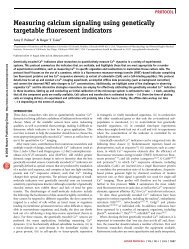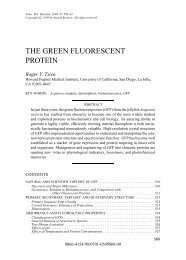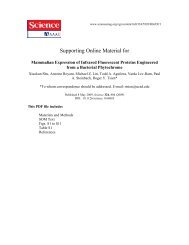Autofluorescent Proteins with Excitation in the Optical ... - Tsien
Autofluorescent Proteins with Excitation in the Optical ... - Tsien
Autofluorescent Proteins with Excitation in the Optical ... - Tsien
Create successful ePaper yourself
Turn your PDF publications into a flip-book with our unique Google optimized e-Paper software.
positive charge of Arg-197 surpris<strong>in</strong>gly does not have a function<br />
<strong>in</strong> wavelength tun<strong>in</strong>g. In contrast, both R197V and R197T show<br />
<strong>in</strong>creased absorbance at 400 nm (Figure S6B), suggest<strong>in</strong>g that<br />
Arg-197 stabilizes <strong>the</strong> anionic state (<strong>with</strong> 600 nm peak absorption)<br />
of <strong>the</strong> chromophore <strong>in</strong> Neptune.<br />
The R197Y mutation causes a blue-shift of <strong>the</strong> peak excitation<br />
to 594 nm (Figure S6A). This suggests that Tyr-197 may counteract<br />
<strong>the</strong> bathochromic effects of hydrogen bond<strong>in</strong>g to <strong>the</strong> acylim<strong>in</strong>e<br />
oxygen. One possible mechanism may be p p stack<strong>in</strong>g<br />
between Tyr-197 and <strong>the</strong> phenolate r<strong>in</strong>g preferentially stabiliz<strong>in</strong>g<br />
electron distribution away from <strong>the</strong> acylim<strong>in</strong>e group. The absorption<br />
spectrum of Neptune R197Y also shows a dist<strong>in</strong>ct hump<br />
at 557 nm (Figure S6B). This likely reflects <strong>the</strong> presence of a<br />
subpopulation <strong>with</strong> a trans chromophore conformation. The<br />
Neptune precursor mKate conta<strong>in</strong>s both cis and trans chromophores<br />
<strong>in</strong> a pH-dependent manner, and <strong>the</strong> closely related prote<strong>in</strong><br />
eqFP611, which is spectrally similar to <strong>the</strong> mKate precursor<br />
TagRFP, conta<strong>in</strong>s primarily a trans chromophore at neutral pH<br />
<strong>with</strong> an absorption peak at 559 nm. As <strong>in</strong> <strong>the</strong> R197V and R197T<br />
mutants, protonated species absorb<strong>in</strong>g at 400 nm are also present<br />
<strong>in</strong> Neptune R197Y, confirm<strong>in</strong>g <strong>the</strong> importance of Arg-197 <strong>in</strong><br />
stabiliz<strong>in</strong>g <strong>the</strong> anionic state of <strong>the</strong> chromophore <strong>in</strong> Neptune.<br />
Notably, red chromophore maturation still occurs <strong>in</strong> <strong>the</strong><br />
R197V, R197T, and R197Y variants, imply<strong>in</strong>g that a positive<br />
charge at position 197 is not required for chromophore maturation.<br />
Indeed, positive charges that are known to promote chromophore<br />
maturation <strong>in</strong> o<strong>the</strong>r RFPs, namely Arg-92, which catalyzes<br />
r<strong>in</strong>g cyclization (Sniegowski et al., 2005), and Lys-67, which<br />
promotes acylim<strong>in</strong>e formation (Baird et al., 2000), are already<br />
present <strong>in</strong> Neptune, fur<strong>the</strong>r argu<strong>in</strong>g aga<strong>in</strong>st an unique requirement<br />
for a positive charge at 197 for chromophore maturation.<br />
Taken toge<strong>the</strong>r, <strong>the</strong> results of mutational analysis at position<br />
197 <strong>in</strong>dicate that Arg-197 functions to stabilize an anionic cis<br />
chromophore state <strong>in</strong> Neptune.<br />
Interest<strong>in</strong>gly, although critical for <strong>the</strong> bathochromic shift <strong>in</strong><br />
Neptune (Table 2), <strong>the</strong> S158C mutation alone <strong>in</strong> mKate has<br />
a negligible effect on wavelength, whereas <strong>the</strong> comb<strong>in</strong>ation of<br />
S158C and M41G produces a 7 nm red-shift. The reposition<strong>in</strong>g<br />
of Arg-197 seen <strong>in</strong> Neptune may <strong>the</strong>refore be energetically favorable<br />
only upon loss of Met-41 due to coord<strong>in</strong>ated conformational<br />
changes. One possibility may be a Met-41-dependent change <strong>in</strong><br />
barrel ellipticity. The barrel cross-section <strong>in</strong> <strong>the</strong> plane of <strong>the</strong><br />
chromophore is leng<strong>the</strong>ned along <strong>the</strong> axis parallel to <strong>the</strong> chromophore<br />
<strong>in</strong> Neptune relative to mKate (20.0 A˚ versus 19.7 A˚<br />
measured between <strong>the</strong> Ca atoms of residues 197 and 117), while<br />
it is narrower along <strong>the</strong> axis perpendicular to <strong>the</strong> chromophore<br />
(21.0 A˚ versus 21.5 A˚ between residues 41 and 175). A change<br />
<strong>in</strong> barrel ellipticity may be required for Arg-197 to assume its<br />
conformation <strong>in</strong> Neptune but may be energetically disfavored<br />
<strong>in</strong> <strong>the</strong> presence of <strong>the</strong> Met-41 side cha<strong>in</strong> due to <strong>in</strong>compatible<br />
pack<strong>in</strong>g <strong>in</strong>teractions.<br />
The mechanisms of red-shift<strong>in</strong>g by Y194F and S62C are less<br />
clear, although toge<strong>the</strong>r <strong>the</strong>y account for ano<strong>the</strong>r 7 nm of <strong>the</strong><br />
14 nm difference between mKate and Neptune excitation peaks<br />
(Table 2). With<strong>in</strong> <strong>the</strong> Neptune structure, <strong>the</strong>se residues are<br />
located near residues <strong>in</strong>volved <strong>in</strong> red-shift<strong>in</strong>g, namely Cys-158,<br />
Arg-197, and Gly-41. Y194F resides at <strong>the</strong> dimeric <strong>in</strong>terface,<br />
but its 4 nm contribution to red-shift<strong>in</strong>g does not depend on<br />
dimerization, as Neptune spectra and quantum yield were <strong>in</strong>de-<br />
Table 4. Characteristics of mNeptune versus IFP1.4<br />
Prote<strong>in</strong> mNeptune IFP1.4<br />
Peak excitation (nm) 600 684<br />
Peak emission (nm) 650 708<br />
Ext<strong>in</strong>ction coefficient (M 1 cm 1 ) 67.000 92,000<br />
Quantum yield 0.20 0.07<br />
Overall brightness a<br />
13.4 6.4<br />
Photostability a<br />
160 8.4<br />
Green emission component present absent<br />
Cofactor dependence none biliverd<strong>in</strong><br />
Molecular weight (kDa) 30 36<br />
Stoichiometry (at 5 mM)<br />
a<br />
Calculated as <strong>in</strong> Table 1.<br />
monomer-dimer<br />
equilibrium<br />
monomer<br />
pendent of concentration from 0.25 mM to16mM (Table S4).<br />
Fur<strong>the</strong>rmore, <strong>the</strong> red-shift is ma<strong>in</strong>ta<strong>in</strong>ed even after <strong>the</strong> <strong>in</strong>troduction<br />
of <strong>the</strong> monomeriz<strong>in</strong>g mutation M146T (Figure 1 and Table 1).<br />
Instead, we hypo<strong>the</strong>size that <strong>the</strong> Y194F may lead to conformational<br />
changes at <strong>the</strong> b barrel surface that are propagated to<br />
<strong>the</strong> nearby Cys-158 and Arg-197 side cha<strong>in</strong>s. S62C is also likely<br />
to function via subtle conformational changes. Through steric<br />
<strong>in</strong>teractions, S62C may alter <strong>the</strong> position<strong>in</strong>g of <strong>the</strong> <strong>in</strong>ternal a helix<br />
to which <strong>the</strong> chromophore is l<strong>in</strong>ked at its acylim<strong>in</strong>e group. This<br />
reposition<strong>in</strong>g may <strong>in</strong>fluence <strong>the</strong> strength of <strong>the</strong> hydrogen bond<br />
between <strong>the</strong> water molecule and <strong>the</strong> acylim<strong>in</strong>e oxygen.<br />
DISCUSSION<br />
1176 Chemistry & Biology 16, 1169–1179, November 25, 2009 ª2009 Elsevier Ltd All rights reserved<br />
Chemistry & Biology<br />
Fluorescent <strong>Prote<strong>in</strong>s</strong> <strong>with</strong> Far-Red <strong>Excitation</strong><br />
Hemoglob<strong>in</strong> effectively absorbs light at wavelengths below 600<br />
nm and impedes imag<strong>in</strong>g of traditional autocatalytic fluorescent<br />
prote<strong>in</strong>s <strong>in</strong> deep tissues of mammals. The development of fluorescent<br />
prote<strong>in</strong>s that excite effectively <strong>in</strong> <strong>the</strong> optical w<strong>in</strong>dow at<br />
600 nm and above is <strong>the</strong>refore highly desirable (Ntziachristos,<br />
2006). We have eng<strong>in</strong>eered fluorescent prote<strong>in</strong>s <strong>with</strong> excitation<br />
peaks at 600 nm and above through a strategy of random and<br />
site-directed mutagenesis. The brightest of <strong>the</strong>se, Neptune,<br />
can be detected us<strong>in</strong>g excitation wavelengths commonly used<br />
for <strong>the</strong> organic fluorophore Cy5 and performs well <strong>in</strong> <strong>in</strong>travital<br />
imag<strong>in</strong>g <strong>in</strong> mammals. As a ‘‘traditional’’ Cnidarian autocatalytic<br />
fluorescent prote<strong>in</strong>, Neptune encodes its own chromophore, <strong>in</strong><br />
contrast to phytochrome-based fluorescent prote<strong>in</strong>s such as<br />
<strong>in</strong>frared fluorescent prote<strong>in</strong>. Thus its brightness is not dependent<br />
on <strong>the</strong> availability of cofactors such as <strong>the</strong> biliverd<strong>in</strong>. Table 4<br />
summarizes current relative advantages of Neptune versus<br />
<strong>in</strong>frared fluorescent prote<strong>in</strong>s.<br />
It would be useful to fur<strong>the</strong>r evolve fluorescent prote<strong>in</strong>s to<br />
produce even more red-shifted variants <strong>in</strong> <strong>the</strong> future. To this<br />
end, understand<strong>in</strong>g wavelength tun<strong>in</strong>g mechanisms <strong>in</strong> autocatalytic<br />
fluorescent prote<strong>in</strong>s <strong>in</strong>forms future strategies to evolve additional<br />
color variants. The crystal structure of Neptune that we<br />
describe here reveals a novel mechanism for excitation wavelength<br />
red-shift<strong>in</strong>g, specifically a new hydrogen bond between<br />
a water molecule and <strong>the</strong> acylim<strong>in</strong>e oxygen of <strong>the</strong> chromophore.<br />
Hydrogen bond<strong>in</strong>g also occurs between <strong>the</strong> acylim<strong>in</strong>e oxygen<br />
and <strong>the</strong> side cha<strong>in</strong> of an <strong>in</strong>ternal am<strong>in</strong>o acid, Glu-16, <strong>in</strong> mPlum,<br />
but this <strong>in</strong>teraction selectively causes a red-shift <strong>in</strong> <strong>the</strong> emission






